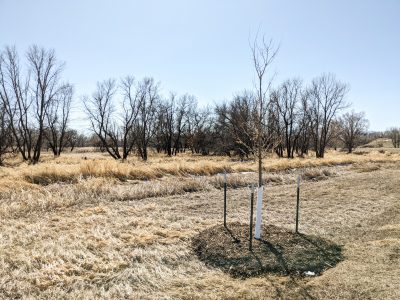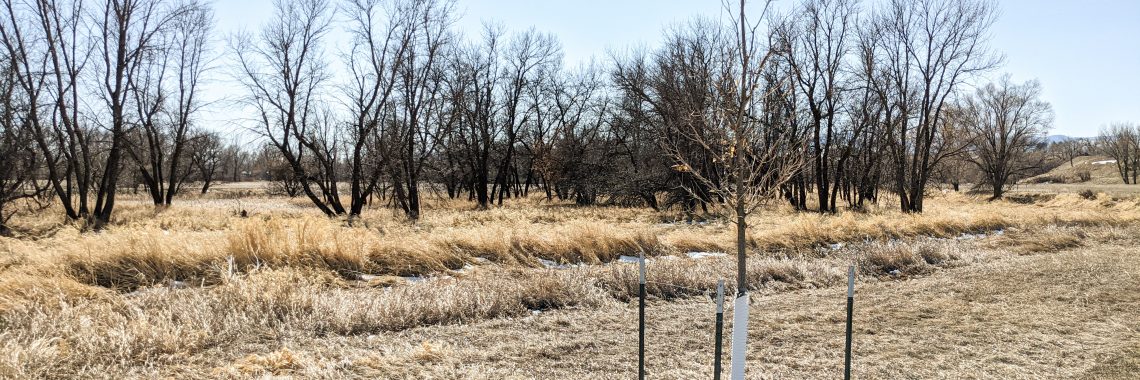
Trees require regular care and maintenance, particularly newly planted trees.
Placing a layer of mulch around the base of a tree is a simple but important step in the tree planting process homeowners can do to care for their investment and increase the likelihood of establishing a tree.
“Why is mulch important?” is one of the big questions regularly asked when planting trees. Let’s explore this and several other questions concerning mulching.
Why should I use mulch?/Why is mulching important?
Incorporating a mulch ring serves numerous purposes. Depending on the type of mulch, it can increase the soil organic matter as it breaks down. The added layer helps insulate the soil directly beneath the mulch layer, which provides moisture retention, reduces extreme heat, and aids soil cooling.
Additionally, if there is a mulch ring instead of grass growing next to the tree’s trunk, grounds maintenance workers and homeowners are less likely to cause damage by hitting the trunk with machinery. A 2- to 4-inch deep layer of mulch can reduce the likelihood of grass or weed seeds germinating, which reduces competition for resources like water and nutrients for the root system.
What are the mulch options?
Mulches are organic or inorganic. There are always benefits and challenges associated with any of these options discussed later in this article. The most common organic mulches in landscapes include shredded bark, chipped wood/bark, pine straw (needles from pine trees), dried grass clippings, mulched leaves, and compost.
Commonly used inorganic mulches include: rocks (pea gravel, river rock, cobblestones, lava rock, etc.), rubber mats, pulverized rubber, and landscape fabric or plastic.
Some concerns landowners have usually include how to keep it from blowing away and how often it needs replacing.
Using a larger chipped mulch will help keep it from blowing away; shredded bark tends to create mats less likely to blow away in the wind. Rocks are typically heavy enough to eliminate the need to be concerned about the wind. Watering the mulch soon after application will help compact it down, so there is not much space for wind to get underneath it to lift and blow it away. You could also consider using edging material to create a physical barrier to keep the mulch in place.
If using organic mulches, you will need to replenish as it breaks down and turns into soil. Anticipate as frequently as twice a year to as long as three years, depending on the situation. Materials that do not break down, such as rocks and rubber mats, will less likely have to be replaced unless the material is carried away by wind; however, you will need to check the rubber mats and other weed barrier fabrics from time to time to ensure they are not restricting the trunk’s growth (girdling).
Where can I get the best mulch for my situation?
Mulch can be purchased from landscape material providers, garden centers, nurseries, and big box stores. Some municipalities across the state offer mulching and composting programs where residents can access free or reduced‑cost mulch or compost. See the table below for information that may be useful for your area. Check with your local public works department to see if there is a program available if your community is not included in this list.
You can also make mulch from yard waste. If grass clippings collected from mowing the lawn are used, make sure they are dried so it does not create a thatch layer. Additionally, be mindful of fertilizers and herbicides the lawn may have been treated with and the effects those products may have on the tree. You can mulch leaf litter; however, if you are dealing with fungal issues, make sure only to use clean leaf litter so fungal spores or other pathogens, such as powdery mildew, are not spread.
What is the proper application?
Numerous sources recommend for Wyoming that a 2- to 4-inch layer is sufficient to reduce the likelihood of weed or grass growth and reap the benefits of using mulch. The diameter of the mulch ring depends on the space. You can use the root ball as a guide for the area to mulch if planting a new tree; however, if you want to make sure lawn mowers or string trimmers are not going to hit the tree’s trunk, you can make the ring as large as you want. Some municipalities create 10‑foot radius mulch rings.
Another recommendation is to remove any grass from the area you intend to place the mulch. You can mechanically remove the turf’s layer or use chemicals to kill the turf. Be sure not to spray the chemical on any leaves or roots of the tree and read the label to ensure the product used will not have any residual effects on trees.
Lastly, do not pile the mulch up against the trunk of the tree. This can trap moisture against the bark, leading to insect and disease issues or harbor rodents. Laying a layer thicker than the 2 to 4 inches can reduce water penetration leading to stress, or in wet soils, can lead to root rot.
What are the challenges associated with certain types of mulch?
There are some challenges with the different types of mulch.
Dyed mulch has the potential to fade and will need refreshing to keep the aesthetic. Fabrics can shelter vertebrate pests such as voles, rabbits, and other rodents known to girdle young trees, depending on the material. Plastic mulches may not allow for moisture penetration and may excessively heat the soil. If not removed after time, the tree may grow around the material, leading to girdling.
There are many resources available for landowners to choose from, including local University of Wyoming Extension offices, local garden centers, and the Wyoming Tree Owner’s Manual, bit.ly/wyo‑tree‑owners.
For a quick reference, the International Society of Arboriculture Proper Mulching Techniques publication can be easily found here, bit.ly/proper‑mulching.
|
Community |
Community wood waste mulching program? |
Mulch available for free or at a reduced cost? |
For more information |
|
Cheyenne |
Yes |
Yes |
www.cheyennecity.org/Your‑Government/Departments/Public‑Works/Compost‑Facility |
|
Cody |
Yes |
Yes |
|
|
Douglas |
Yes |
Yes |
|
|
Gillette |
Yes |
Yes |
www.gillettewy.gov/city‑government/departments/public‑works/sustainability/compost |
|
Jackson |
Yes |
No |
|
|
Laramie |
Yes |
Yes |
|
|
Lovell |
Maybe |
Yes |
Word of mouth—call Town Hall (307) 548‑6551 |
|
Newcastle |
Yes |
Yes |
Email trees@cityofnewcastle.org for more information |
|
Powell |
Yes |
Yes |
Call Parks Department (307) 754‑9417 |
|
Riverton |
Yes |
Maybe |
Tara Costanzo is the community forestry coordinator with the Wyoming State Forestry Division. She can be contacted at tara.costanzo@wyo.gov or (307) 777‑3626.
Article originally published in the Summer 2021 issue of Barnyards & Backyards magazine. To subscribe, click here.





